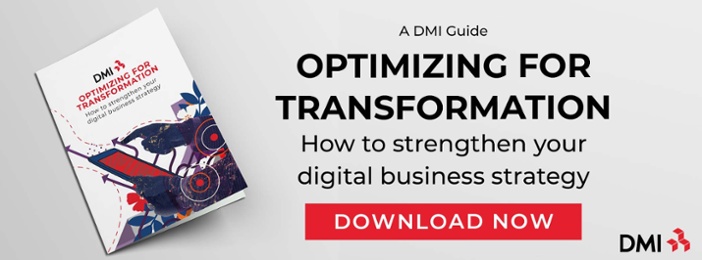
Federal Agencies Must Embrace the Next Generation of Managed IT Services
“Many government CIOs say their digital initiatives are maturing, but they often confuse progress with maturity,” according to Gartner. “[They] recognize the value of digital government transformation and understand that their agencies must be agile and innovative to succeed, but struggle to be responsive in developing and successfully completing digital initiatives.”
Why? Organizational complexities, legacy systems and compliance are just some of the factors that can impede transformation and innovation in federal environments.
Focusing on digital optimization first is often the best way forward.
At DMI, our Next Generation Managed IT Services Model incorporates continuous optimization to help our federal clients meet their business goals. More specifically, by optimizing their managed IT services, federal agencies can drive efficiency, improve user experience and minimize IT spend — all of which are needed to scale.
The Challenges of Digitally Transforming Federal Agencies
Digital transformation is different in federal environments than in commercial ones.
According to McKinsey, federal agencies spend, on average, 78% of their IT budgets on operating and maintaining legacy systems; for some, 90%. The multiplying costs of operating and maintaining legacy infrastructure cut into federal IT budgets, making it difficult to modernize existing systems or develop new ones.
Digital initiatives in federal environments also require ample guidelines and restrictions. Of course, there are good reasons for such procedures — regulators want to ensure that taxpayers’ money is appropriately spent and that all data is secure. Federal agencies must be even more cautious than commercial businesses, as a result.
Compliance and security procedures and multilevel approval processes, for example, may slow down project pacing because staff will likely need to complete tasks in an intended sequence. They will also need to spend more time planning, executing and documenting operations.
Digital projects that fail to meet established requirements may become delayed or halt altogether. They can also accrue additional expenses.
Finally, government agencies need to assemble the right talent to elevate their digital environment. They have to figure out what skills they require from their project staff; for example, software architects who can build advanced analytics applications. Other roles to look for include product owners, designers and user-experience specialists.
Due to limited resources, however, federal agencies may delegate these roles to management and other in-house team members. However, this approach can distract key staff from the core business.
Digital Optimization Offers a Path Forward
Despite the complexities, digital transformation and innovation are necessary in federal environments. Both ensure that agencies utilize future-proof capabilities, thus reducing overall cost and improving user experience.
Fortunately, optimizing an agency’s managed IT services can provide a path forward.
Digital optimization is a strategy focused on improving current operating processes and business models, rather than making wholesale technological changes. As a result, optimization creates efficiencies that allow organizations to shift IT investments, in addition to other significant benefits.
All of DMI’s managed IT services are continuously optimized to help federal agencies perform and scale:
- Data Center Operations Services: Compute, Storage, Mainframes, Middleware, Cloud Migration, etc.
- Network Services: Distributed Network, Network Monitoring, Network Security Management, etc.
- Unified Communication Services: Collaboration, Conference management, Telephony Support, etc.
- Client Services: Mobile Device Management, Desktop Engineering, Patch Management, etc.
- Service Desk Services: Onsite Support, Very, Very Important Person [VVIP]/VIP Support, Field Support.
- Monitoring & Event Management Services: Continuous Monitoring, Enterprise Operations Center, etc.
- Cross Functional Services: Engineering Support, Project Management, Change Management, IT Asset Management.
DMI has narrowed in on a specific plan to digitally optimize the above services in federal environments. Rather than managing services based on time and materials, our team relies on a per-unit approach. This, in addition to outsourcing, converts fixed IT costs into variable costs and allows federal agencies to budget more effectively. In other words, you only pay for what you use — when you need it.
“Commercial managed services have been following the per-unit model for years,” says Jay Lodge, Senior Vice President Federal Civilian at DMI. “I believe that’s the direction federal agencies are and should be going.”
Another key component of DMI’s approach to managed services is successfully incorporating Service-Level Agreements, or ‘SLAs’. The SLA will show that both sides have the same understanding of IT and business requirements. The agreement also includes established metrics and expectations, so neither party is in the dark if service issues arise. Likewise, both parties can monitor performance, ensuring consistent results while supporting both compliance and security.
A New But Knowledgeable Player in the Federal Space
Our SLA-driven, per-unit, performance-based approach to digital optimization and managed IT services drives measurable success in and across federal agencies. For example, our team works with the Federal Deposit Insurance Corporation (FDIC) to bring efficiencies in staffing through automation of core processes, thereby improving resource optimization and laying the foundations for successful transformation and innovation.
Using our Next Generation Managed IT Services Model, we help our federal clients build solutions that increase interoperability, responsiveness and cost-effectiveness. DMI will work with you to implement solutions that transform agency operations and align innovative, robust and versatile technology with mission success. We also leverage Artificial Intelligence (AI) and Robotic Process Automation (RPA) to increase end-user experience while optimizing operations.
Want to know more about our experience with digitally optimizing managed IT services for federal agencies? Contact us.
